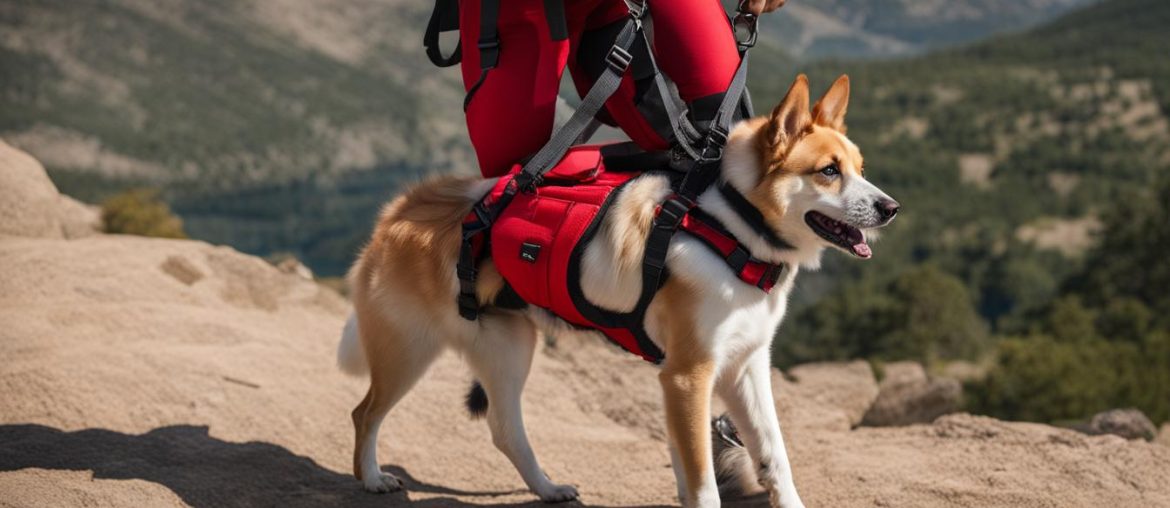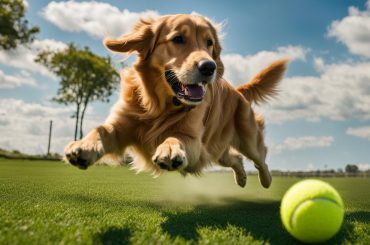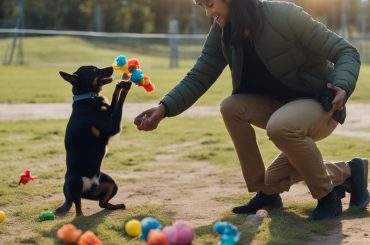When it comes to teaching your dog to put on a harness, there are a few key steps to keep in mind. I recommend that you choose the right harness that allows for natural movement and doesn’t restrict your dog’s shoulders. Look for a harness that can be clipped around the neck and body, especially if your dog is head-shy. The harness should fit well, with enough room for a finger to fit comfortably between the straps and your dog’s body.
Introducing the harness gradually is crucial in ensuring your dog feels comfortable and confident. Start by placing the harness on the floor and rewarding your dog with tasty treats for investigating it. Slowly progress to placing the harness over their head and doing up the clips while continuing to reward them with treats. By making the process positive and rewarding, your dog will soon associate the harness with a pleasant experience.
Key Takeaways:
- Choose a harness that allows for natural movement and fits well.
- Introduce the harness gradually, starting with placing it on the floor.
- Reward your dog with treats throughout the training process.
- Make the harness a fun and positive experience for your dog.
- Regular training and practice are essential for successful harness training.
Why Harness Training is Important for Your Dog
Teaching your dog to wear a harness properly is an essential part of their training and overall well-being. Harness training offers numerous benefits for both you and your furry friend. By using a harness, you can provide better control during walks and other outdoor activities while ensuring your dog’s comfort and safety.
One of the main reasons why harness training is important is that it helps prevent strain or injury to your dog’s neck and throat. Unlike collars, which can put pressure on these sensitive areas, harnesses distribute the force of pulling more evenly across the body. This is particularly beneficial for dogs that tend to pull on the leash or have respiratory issues.
Additionally, harness training allows you to have better control over your dog, especially when they are still learning to walk on a lead or in potentially hazardous environments. It gives you the ability to redirect their movements and prevent them from pulling or lunging. This level of control is particularly important for larger or stronger dogs.
The Benefits of Harness Training
Harness training provides several advantages for both you and your dog:
- Improved control during walks
- Reduced strain on the neck and throat
- Prevention of choking or damage to the windpipe
- Easier identification with the use of an attached collar and identity tag
- Enhanced comfort and safety for your dog
Overall, harness training is a worthwhile investment in your dog’s training and well-being. It allows you to have better control, prevents potential injuries, and ensures your dog’s overall comfort and safety during walks and other outdoor activities.
| Benefits of Harness Training |
|---|
| Improved control during walks |
| Reduced strain on the neck and throat |
| Prevention of choking or damage to the windpipe |
| Easier identification with the use of an attached collar and identity tag |
| Enhanced comfort and safety for your dog |
By properly training your dog to wear a harness, you can ensure a positive and enjoyable experience for both of you during walks and other outdoor adventures. Taking the time to introduce the harness gradually, using positive reinforcement and rewards, will help your dog feel comfortable and confident in their new gear.
Steps to Introduce the Harness
Introducing a harness to your dog can be a gradual process that involves patience and positive reinforcement. By following these step-by-step tips, you can help your dog feel comfortable and confident wearing a harness.
Gather the Necessary Supplies
Before starting the harness training process, gather the necessary supplies. You will need a properly fitting harness, tasty treats, and a quiet and comfortable environment for your dog to feel relaxed.
Step 1: Let Your Dog Investigate
Start by placing the harness on the floor and allow your dog to explore it while scattering tasty treats around it. This will help create positive associations with the harness.
Step 2: Gradual Introduction
Once your dog is comfortable with the harness on the floor, gently lift it and feed treats through the head-hole without requiring them to put their head through yet. This helps your dog associate the harness with positive rewards.
Step 3: Encourage Nose and Mouth Through the Head-Hole
Hold a treat and move it backwards away from the head-hole, encouraging your dog to push their nose and mouth through to take the reward. Continue rewarding your dog while gently placing the harness around their neck and letting it hang loosely.
Step 4: Do Up the Clips and Reward
If your dog shows no signs of concern, progress to doing up the clips of the harness while rewarding them with treats. Make sure to praise and reward your dog for their cooperation throughout the process.
To put it simply, each dog is different, and the time it takes for them to feel comfortable with wearing a harness may vary. Be patient and provide plenty of positive reinforcement to make the experience enjoyable for your furry friend.

Table: Example Harness Training Timeline
| Day | Training Activity |
|---|---|
| Day 1 | Introduce harness on the floor with treats |
| Day 2 | Lift harness and feed treats through head-hole |
| Day 3 | Encourage nose and mouth through head-hole |
| Day 4 | Place harness around neck and hang loosely |
| Day 5 | Do up clips of the harness and reward |
| Day 6 onwards | Practice putting on the harness and rewarding |
Desensitizing Your Dog to a New Harness
To successfully teach your dog to put on a harness, please desensitize them to the new equipment. This process involves gradually introducing the harness in a positive and rewarding manner, creating a sense of comfort and familiarity. Desensitization is particularly important for dogs who are sensitive to touch or have had negative experiences with wearing harnesses in the past.
Start by introducing the harness in a calm and quiet environment, allowing your dog to approach it at their own pace. Use positive reinforcement techniques, such as offering treats and praise, to associate the harness with positive experiences. You can also engage in fun activities, like playing games or offering toys, while the harness is in sight. The goal is to create positive associations and make the harness a desirable object for your dog.
Take your time during the desensitization process. Gradually progress to having your dog sniff the harness, touch it with their nose, and eventually put their head through the head-hole. Try to reward your dog every step of the way to reinforce positive behavior. If your dog shows signs of anxiety or discomfort, take a step back and proceed more slowly. Patience and consistency are key to helping your dog become comfortable with wearing a harness.

Benefits of Desensitizing Your Dog to a New Harness
Desensitizing your dog to a new harness has several benefits. First and foremost, it ensures that your dog feels comfortable and safe while wearing the harness, reducing stress and anxiety. It also helps to build a positive association with the harness, making future training sessions easier and more enjoyable. Additionally, desensitization can improve your dog’s overall behavior, as they learn to trust and cooperate with the training process.
Tips for Successful Desensitization
- Start in a quiet environment with minimal distractions.
- Use positive reinforcement techniques, such as treats and praise.
- Take it slow and progress at your dog’s pace.
- Be patient and understanding if your dog shows signs of discomfort.
- Make the desensitization process fun and engaging by incorporating games and rewards.
- Seek the help of a professional trainer if you encounter persistent challenges.
Final Thoughts
Desensitizing your dog to a new harness is an essential step in the training process. By taking the time to create positive associations and gradually introducing the harness, you can ensure that your dog feels comfortable and confident while wearing it. Try to be patient, consistent, and reward positive behavior. With the right approach, you can successfully teach your dog to put on a harness and enjoy the many benefits it provides.
Making the Harness Fun for Your Dog
When it comes to harness training, making the process fun and enjoyable for your dog is key to their success. By incorporating games and activities that your dog loves, you can create positive associations with wearing a harness. This not only makes the training process easier but also helps your dog feel comfortable and confident in their harness.
One effective method is to use the harness during playtime. For example, you can play fetch with the harness on, or incorporate it into a fun training game. By associating the harness with something enjoyable, your dog will start to see it as a positive and rewarding experience.
Another way to make the harness fun is by rewarding your dog with treats and praise while they are wearing it. Whenever you put the harness on, give them a tasty treat or shower them with praise. This positive reinforcement helps your dog associate the harness with something they enjoy, reinforcing their willingness to wear it.
Try to always pay attention to your dog’s body language. If they show any signs of discomfort or resistance, take it slow and adjust your training methods accordingly. The goal is to make the harness a positive and enjoyable part of your dog’s routine, ensuring they are happy and comfortable during walks and other activities.

| Benefits of Making the Harness Fun |
|---|
| 1. Positive association with wearing a harness |
| 2. Increased willingness and cooperation from your dog |
| 3. Improved comfort and confidence in wearing the harness |
Key Takeaways:
- Make harness training a positive and enjoyable experience for your dog
- Incorporate games and activities that your dog loves
- Reward your dog with treats and praise while they are wearing the harness
- Pay attention to your dog’s body language and adjust your training methods accordingly
What to Do If Your Dog Already Hates Their Harness
If your dog already has a negative association with their harness, address their concerns and work on building a positive relationship with it. Start by defining your goal behavior, such as having your dog remain still and comfortable while you put the harness on. Break down the behavior into smaller steps and create a training plan to gradually desensitize your dog to the harness. Focus on using positive reinforcement and rewarding calm and relaxed behavior. If necessary, seek the help of a professional trainer to assist you in the process.
To help your dog overcome their negative feelings towards the harness, create a positive and rewarding experience. You can use treats, toys, or playtime to help distract and engage your dog while you put on the harness. Start by rewarding small steps, such as your dog approaching the harness willingly or allowing you to touch it without showing signs of fear or discomfort.
I highly suggest that you be patient and understanding throughout the process. Rushing or forcing your dog to wear the harness can further reinforce their negative association and make it more difficult to overcome their aversion. Take small steps, gradually increasing the duration and difficulty, while always providing positive reinforcement and rewards.
To put it simply, every dog is different, and it may take time for your dog to feel comfortable wearing a harness. By remaining patient, consistent, and using positive reinforcement, you can help your dog overcome their dislike and develop a positive association with wearing a harness. With time and effort, your dog will learn to trust the harness and associate it with enjoyable and rewarding experiences.

The Benefits of Using a Harness
When it comes to training your dog to wear a harness, there are numerous benefits that make it worth the effort. Harnesses provide better control, especially for dogs that tend to pull on the leash. Unlike collars, a harness distributes the force of pulling more evenly, reducing strain on your dog’s neck and throat. This not only prevents choking or damage to the windpipe but also makes it a safer option for breeds prone to respiratory issues.

Additionally, a harness allows for easier identification. By attaching an identity tag to the collar, you can easily ensure that your dog can be identified in public spaces. This is important for compliance with the law and for the safety of your furry friend in case they ever get lost or separated from you.
Overall, training your dog to wear a harness is a worthwhile investment in their comfort and safety. With a harness, you can enjoy better control, prevent injury, and have peace of mind during walks and other outdoor activities. So, take the time to introduce the harness gradually, using positive reinforcement, and make it a positive and enjoyable experience for your dog.
Choosing the Right Harness
When it comes to harness training for dogs, choosing the right harness is crucial to ensure your dog’s comfort and safety. Here are some key factors to consider when selecting a harness:
- Fit: Look for a harness that allows for natural movement and doesn’t restrict your dog’s shoulders. Avoid harnesses that cross directly in front of the shoulders, as they can impede your dog’s freedom of movement.
- Design: Opt for a harness that can be clipped around the neck and body, especially if your dog is head-shy. This design allows for easier and less stressful handling during the harnessing process.
- Size: The harness should fit well, with enough room for a finger to fit comfortably between the strapping and your dog’s body. A properly fitting harness ensures that your dog is secure without causing any discomfort or chafing.
Regularly check the harness, collar, and lead for wear and tear to ensure they remain in good condition. This is especially important if you have an active or strong dog that may put extra strain on the equipment.
To put it simply, every dog is unique, and what works for one may not work for another. I recommend that you assess your dog’s individual needs and preferences when selecting a harness. If you’re unsure, consult with a professional trainer or visit a pet store with knowledgeable staff who can guide you in finding the right harness for your furry friend.

The Importance of Regular Training and Practice
Training your dog to wear a harness is a process that requires regular training and practice. Once your dog is comfortable wearing a harness, continue reinforcing positive behaviors and gradually increasing the duration and distance of walks. Consistency is key in harness training, as it helps your dog become accustomed to the harness and develop good leash manners.
During your training sessions, use positive reinforcement to reward your dog for calm and relaxed behavior while wearing the harness. This can be done through treats, praise, and play. By consistently rewarding good behavior, you reinforce the positive association between wearing the harness and enjoyable experiences for your dog.
In addition to regular training sessions, practice walking on a leash with your dog wearing the harness. Start with short walks and gradually increase the duration and distance as your dog becomes more comfortable. Use the same positive reinforcement techniques to encourage loose leash walking and discourage pulling or lunging.
To put it simply, every dog is different, and some may require more time and patience to become comfortable with wearing a harness. Be patient and understanding, and always pay attention to your dog’s body language to ensure they are comfortable throughout the training process. With consistent training and practice, your dog will become more confident and comfortable wearing a harness.

Benefits of Regular Training and Practice
Regular training and practice have numerous benefits for your dog’s harness training. By consistently reinforcing positive behaviors and practicing walking on a leash, you can:
- Build a positive association between wearing the harness and enjoyable experiences
- Improve your dog’s leash manners and prevent pulling or lunging
- Enhance your dog’s confidence and comfort level while wearing the harness
- Strengthen the bond between you and your dog through positive reinforcement
- Ensure your dog’s safety and control in various outdoor environments
Through regular training and practice, you can help your dog become a well-behaved and confident companion during walks and other outdoor activities.
Troubleshooting Common Challenges
Training your dog to wear a harness can sometimes come with challenges, but with patience and persistence, most issues can be resolved. Here are some common challenges you may encounter and tips on how to overcome them:
Resistance to Putting on the Harness
If your dog resists or retreats when you try to put on the harness, go back to the previous step and reinforce positive associations. Start by letting your dog investigate the harness on the floor and rewarding them with treats. Gradually progress to holding treats near the head-hole and encouraging them to put their nose and mouth through. If your dog shows any signs of discomfort or resistance, take a step back and continue reinforcing positive associations until they are comfortable.
Pulling or Escaping during Walks
If your dog pulls or tries to escape the harness during walks, I would advise that you address this behavior through training techniques that discourage pulling and reinforce loose leash walking. Use positive reinforcement and reward your dog for walking calmly beside you. Practice leash training exercises in a controlled environment and gradually increase the level of distractions. Be patient and consistent with your training, and seek the help of a professional trainer if needed.
Overall Discomfort or Dislike of the Harness
Sometimes, dogs may develop an overall discomfort or dislike of wearing the harness. In such cases, please desensitize them to the harness by introducing it gradually in a positive and rewarding way. Use treats, games, and other fun activities to associate the harness with positive experiences. Take it slow and be patient, allowing your dog to build a positive relationship with the harness over time.

To put it simply, troubleshooting common challenges in harness training requires patience, persistence, and a positive approach. Pay attention to your dog’s body language and adjust your training methods accordingly. Seek professional help if you encounter persistent challenges or need additional guidance. With the right training techniques and a little time, your dog will soon be comfortable and confident wearing a harness.
Final Thoughts
Training your dog to wear a harness is an essential skill that provides better control, safety, and comfort during walks and outdoor activities. By choosing the right harness, introducing it gradually, and using positive reinforcement, you can help your dog feel comfortable and confident wearing it.
When fitting a harness, ensure that it allows for natural movement and doesn’t restrict your dog’s shoulders. Look for a harness that can be clipped around the neck and body, especially if your dog is head-shy. The fit should be snug but comfortable, with enough room for a finger to fit between the strapping and your dog’s body.
Start by desensitizing your dog to the harness, using tasty treats and positive associations to make it a fun experience. Gradually progress to placing the harness over their head and doing up the clips, rewarding them with treats each step of the way. Be patient, take it slow, and reinforce positive behaviors through regular training and practice.
To put it simply, if your dog already has a negative association with their harness, address their concerns and work on building a positive relationship. Break down the training into smaller steps, use positive reinforcement, and seek professional help if needed. Harness training is an investment in your dog’s comfort, safety, and overall well-being.
FAQ
How do I teach my dog to put on a harness?
To teach your dog to put on a harness, choose the right harness that allows for natural movement and doesn’t restrict your dog’s shoulders. Introduce the harness gradually, starting by placing it on the floor and rewarding your dog with treats. Slowly progress to placing the harness over their head and doing up the clips while rewarding them with treats.
Why is harness training important for my dog?
Harness training is important for your dog’s health, wellbeing, and safety. Using a harness provides better control, especially for dogs that tend to pull on the leash. It also prevents choking or damage to the windpipe, making it a safer option for breeds prone to respiratory issues.
How do I introduce the harness to my dog?
To introduce the harness, start by placing it on the floor and letting your dog investigate it while scattering tasty treats around it. Gradually lift the harness and feed treats through the head-hole without requiring them to put their head through yet. Once they are comfortable, encourage your dog to push their nose and mouth through the head-hole to take a treat. Then, gently place the harness around their neck and let it hang loosely while feeding treats.
What should I do if my dog is sensitive to things touching their body?
If your dog is sensitive, desensitize them to the harness before attempting to put it on. Start by gradually introducing the harness in a quiet environment, using positive reinforcement and treats to create positive associations. Take your time and be patient during this process.
How can I make the harness a fun experience for my dog?
To make the harness a fun experience, associate it with games or activities your dog enjoys. You can play fetch with the harness or incorporate it into a fun training game. By making the harness part of a positive and engaging activity, your dog will start to see it as something enjoyable rather than something to be fearful of.
What should I do if my dog already hates their harness?
If your dog already has a negative association with their harness, address their concerns and work on building a positive relationship with it. Start by breaking down the behavior into smaller steps and creating a training plan to gradually desensitize your dog to the harness. Seek the help of a professional trainer if needed.
What are the benefits of using a harness?
Using a harness provides better control, distributes the force of pulling more evenly, and prevents choking or damage to the windpipe. It is especially beneficial for dogs that tend to pull on the leash and breeds prone to respiratory issues. Harnesses also allow for easier identification by attaching an identity tag to the collar.
How do I choose the right harness for my dog?
When choosing a harness, look for one that allows for natural movement and doesn’t restrict your dog’s shoulders. Opt for a harness that can be clipped around the neck and body, especially if your dog is head-shy. The harness should fit well, with enough room for a finger to fit comfortably between the strapping and your dog’s body.
Why is regular training and practice important for harness training?
Regular training and practice help reinforce positive behaviors and ensure that your dog remains comfortable wearing the harness. By regularly putting the harness on your dog and taking them for walks, you can gradually increase their comfort and confidence. Consistency and positive reinforcement are key to successful harness training.
What should I do if I encounter common challenges during harness training?
If you encounter challenges such as resistance or pulling during harness training, go back a step and reinforce positive associations. Adjust your training methods and techniques based on your dog’s body language. Seek the help of a professional trainer if persistent challenges arise.






